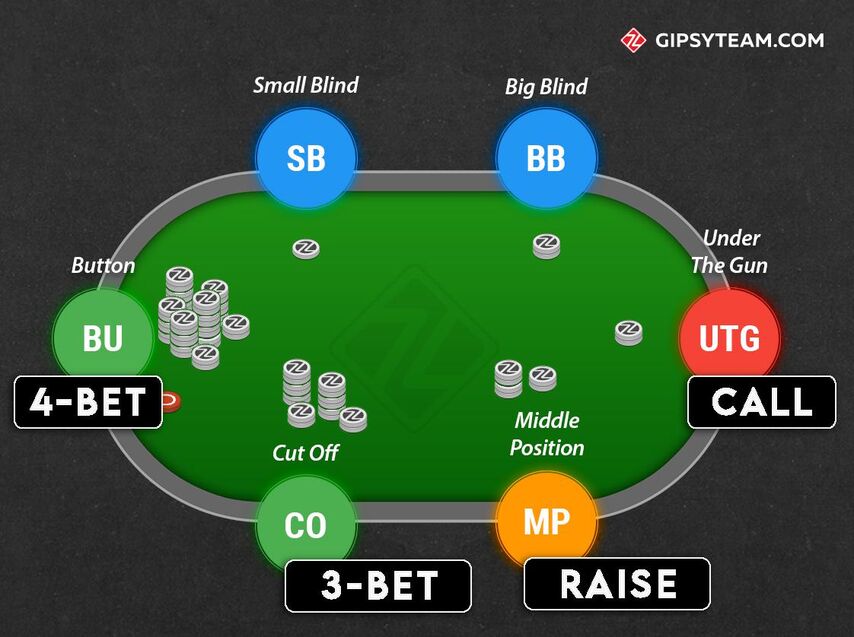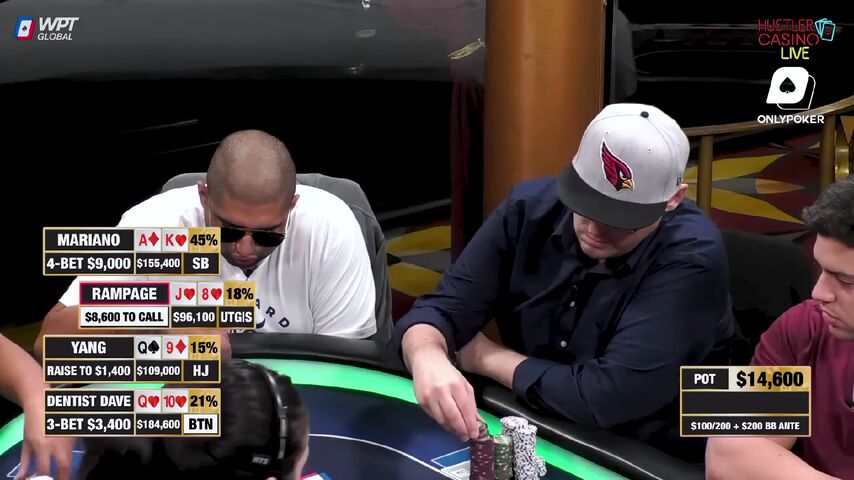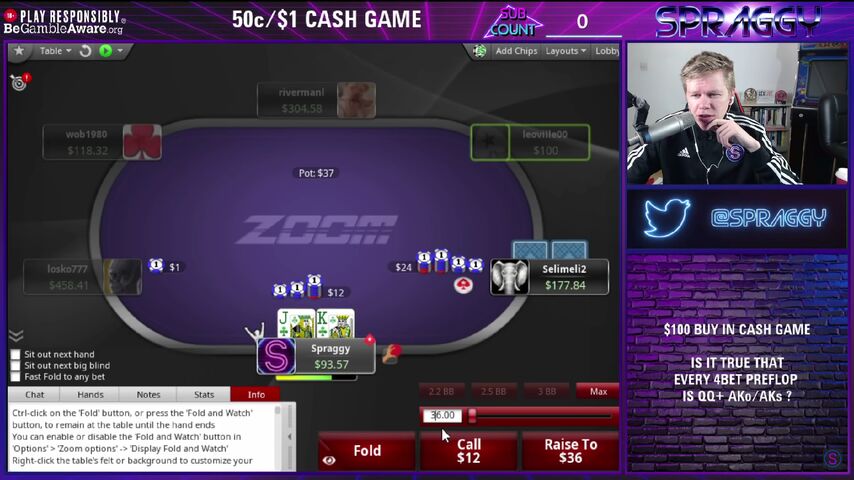A 4-bet is an advanced poker technique for raising opponents, whether you have a premium hand or not. Multiple raises used to be a rare sight, but now they’re just another tool that poker players must get familiar with. Let’s start by answering an important question; what is a 4-bet in poker?
In a betting round of poker, players can check, call, raise, or fold. A 4-bet is the second re-raise in a betting round. One of the other poker terms we’ll use in the article is “3-bet”, referring to the first re-raise.
Take a quick look at this illustration. We see a raise from an early position, then a re-raise (3-bet). The following player makes another re-raise, known as a 4-bet.

Now that you know what a 4-bet is, we need to talk about why to 4-bet and how large a 4-bet should be.
Which Poker Hands Should You 4-Bet With?
Poker used to be a much simpler game and players were quite predictable. Multiple re-raises always meant a premium hand like pocket queens, kings, or aces. For some casual. recreational players at sites like TigerGaming or GGPoker, they might assume the meaning of a 4-bet is always a premium hand.
That being said, the majority of your 4-bets should be with premium hands. Your 4-bet range should generally include pockets aces, kings, queens, and jacks. Ace-king is also a good 4-bet candidate since you block some hands that might be ahead of you (like aces and kings). The aim is to get value from worse hands, which is where sizing the 4-bet becomes important (more about that later).
Only 4-betting with your best hands (the top of your range) is far too predictable. That kind of conservative style of poker may have worked in the past, but nowadays you should occasionally 4-bet as a bluff.
4-bet bluff with hands that you wouldn’t be happy to call a 3-bet with, like suited Ax or Kx hands. The reason you don’t want to call your opponents 3-bet with hands like this is that they’re usually dominated (and have less equity compared to the 3-better’s range). You can also 4-bet with hands that have decent postflop playability, like suited connectors.
Consider the hands you block. If you’re holding an ace, your opponent is less likely to have one (though not impossible). This helps you construct an idea of their range and play better postflop poker, if they choose to call a preflop 4-bet.

The number of players at the table affects your 4-betting. In a smaller game with three players at the table, you might be able to 4-bet with a wider range of hands. The fewer opponents you have, the stronger your range becomes.
There’s less chance of your opponents having better cards because there are only two other players. As the amount of players increases to 9-max, it’s best to tighten your 4-bet range since there’s more chance of an opponent having a stronger hand.
What’s The Right Size For a 4-Bet?
Are you in position or out of position at the table? Your 4-bet size will depend on your position and the size of the 3-bet before your action.
4-bet in position with a size that achieves your goal. Are you trying to get value or apply pressure as a 4-bet bluff? Sizes vary a lot for in-position 4-bets, but they’re usually between 2x and 3x the 3-bet size. Stack sizes, player skill level, and several other factors might make you increase or decrease your 4-bet size.
Choose a larger size if you’re 4-betting from out of position. You’ll be playing with a disadvantage from out of position, so increasing the 4-bet size will make it easier to play against your opponent. You want to avoid choosing a smaller size since your opponent can easily call with a wide range of hands. As the size of the pot increases, it's generally easier to build a range of your opponent’s hands.

On this Americas Cardroom final table, the player holding the ace-king of spades has a big decision to make. Should they 4-bet and commit more chips at a final table (and risk being eliminated) or call the 3-bet to see a flop?
You can try out ACR’s tournaments for yourself or work on your 4-betting at the cash tables. No-limit Texas hold ‘em attracts the most players, followed by fast folding hold ‘em, and then pot-limit Omaha. New players get a 100% matched deposit bonus up to a massive $2000, for all deposits of $10 or more. Our review of America’s Cardroom has everything you need to know.







Think About Position and The Villian Before Making a 4-Bet
In a hand of poker, the villain is your opponent in the hand (not someone evil like the Joker or Bane). It’s very important to consider the player you are 4-betting, plus their position at the table.
Your goal is value, meaning that you should 4-bet when it makes the most sense.
When you’ve been dealt a premium hand, choose the largest 4-bet size that your opponent will call. Increase the size when you’re out of position since they’ll call a larger bet to play against you from their advantageous table position. It will be easier for you to play profitably if you are in position, so you can reduce the size of your 4-bets.
- GipsyTeam's unique promotions
- Help with deposits and cashouts
- Access to private freerolls
- Round-the-clock support
- GipsyTeam's unique promotions
- Help with deposits and cashouts
- Access to private freerolls
- Round-the-clock support
- GipsyTeam's unique promotions
- Help with deposits and cashouts
- Access to private freerolls
- Round-the-clock support
- Уникальные акции от GipsyTeam
- Помощь с депозитами и кешаутами
- Доступ в закрытые фрироллы
- Круглосуточная поддержка
- Уникальные акции от GipsyTeam
- Помощь с депозитами и кешаутами
- Доступ в закрытые фрироллы
- Круглосуточная поддержка
- GipsyTeam's unique promotions
- Help with deposits and cashouts
- Access to private freerolls
- Round-the-clock support
- Уникальные акции от GipsyTeam
- Помощь с депозитами и кешаутами
- Доступ в закрытые фрироллы
- Круглосуточная поддержка
- GipsyTeam's unique promotions
- Help with deposits and cashouts
- Access to private freerolls
- Round-the-clock support
- GipsyTeam's unique promotions
- Help with deposits and cashouts
- Access to private freerolls
- Round-the-clock support
- GipsyTeam's unique promotions
- Help with deposits and cashouts
- Access to private freerolls
- Round-the-clock support
- GipsyTeam's unique promotions
- Help with deposits and cashouts
- Access to private freerolls
- Round-the-clock support
- GipsyTeam's unique promotions
- Help with deposits and cashouts
- Access to private freerolls
- Round-the-clock support
- GipsyTeam's unique promotions
- Help with deposits and cashouts
- Access to private freerolls
- Round-the-clock support
- GipsyTeam's unique promotions
- Help with deposits and cashouts
- Access to private freerolls
- Round-the-clock support
- GipsyTeam's unique promotions
- Help with deposits and cashouts
- Access to private freerolls
- Round-the-clock support
- GipsyTeam's unique promotions
- Help with deposits and cashouts
- Access to private freerolls
- Round-the-clock support
- GipsyTeam's unique promotions
- Help with deposits and cashouts
- Access to private freerolls
- Round-the-clock support
- GipsyTeam's unique promotions
- Help with deposits and cashouts
- Access to private freerolls
- Round-the-clock support
- GipsyTeam's unique promotions
- Help with deposits and cashouts
- Access to private freerolls
- Round-the-clock support
- GipsyTeam's unique promotions
- Help with deposits and cashouts
- Access to private freerolls
- Round-the-clock support
- GipsyTeam's unique promotions
- Help with deposits and cashouts
- Access to private freerolls
- Round-the-clock support
- GipsyTeam's unique promotions
- Help with deposits and cashouts
- Access to private freerolls
- Round-the-clock support
- Уникальные акции от GipsyTeam
- Помощь с депозитами и кешаутами
- Доступ в закрытые фрироллы
- Круглосуточная поддержка
- GipsyTeam's unique promotions
- Help with deposits and cashouts
- Access to private freerolls
- Round-the-clock support
- GipsyTeam's unique promotions
- Help with deposits and cashouts
- Access to private freerolls
- Round-the-clock support
- GipsyTeam's unique promotions
- Help with deposits and cashouts
- Access to private freerolls
- Round-the-clock support
- GipsyTeam's unique promotions
- Help with deposits and cashouts
- Access to private freerolls
- Round-the-clock support
- GipsyTeam's unique promotions
- Help with deposits and cashouts
- Access to private freerolls
- Round-the-clock support
- GipsyTeam's unique promotions
- Help with deposits and cashouts
- Access to private freerolls
- Round-the-clock support
- Уникальные акции от GipsyTeam
- Помощь с депозитами и кешаутами
- Доступ в закрытые фрироллы
- Круглосуточная поддержка
- GipsyTeam's unique promotions
- Help with deposits and cashouts
- Access to private freerolls
- Round-the-clock support
- GipsyTeam's unique promotions
- Help with deposits and cashouts
- Access to private freerolls
- Round-the-clock support
- Уникальные акции от GipsyTeam
- Помощь с депозитами и кешаутами
- Доступ в закрытые фрироллы
- Круглосуточная поддержка
- GipsyTeam's unique promotions
- Help with deposits and cashouts
- Access to private freerolls
- Round-the-clock support
- Уникальные акции от GipsyTeam
- Помощь с депозитами и кешаутами
- Доступ в закрытые фрироллы
- Круглосуточная поддержка
- GipsyTeam's unique promotions
- Help with deposits and cashouts
- Access to private freerolls
- Round-the-clock support
- GipsyTeam's unique promotions
- Help with deposits and cashouts
- Access to private freerolls
- Round-the-clock support
- GipsyTeam's unique promotions
- Help with deposits and cashouts
- Access to private freerolls
- Round-the-clock support
- Уникальные акции от GipsyTeam
- Помощь с депозитами и кешаутами
- Доступ в закрытые фрироллы
- Круглосуточная поддержка
- GipsyTeam's unique promotions
- Help with deposits and cashouts
- Access to private freerolls
- Round-the-clock support
- GipsyTeam's unique promotions
- Help with deposits and cashouts
- Access to private freerolls
- Round-the-clock support
- GipsyTeam's unique promotions
- Help with deposits and cashouts
- Access to private freerolls
- Round-the-clock support
- GipsyTeam's unique promotions
- Help with deposits and cashouts
- Access to private freerolls
- Round-the-clock support
- Уникальные акции от GipsyTeam
- Помощь с депозитами и кешаутами
- Доступ в закрытые фрироллы
- Круглосуточная поддержка
- GipsyTeam's unique promotions
- Help with deposits and cashouts
- Access to private freerolls
- Round-the-clock support
- GipsyTeam's unique promotions
- Help with deposits and cashouts
- Access to private freerolls
- Round-the-clock support








































Have a Plan If Your 4-Bet is Called (Or You Get Raised)
If you make a preflop 4-bet with pocket queens, what will you do when a king or ace comes on the flop? It’s a good idea to have a strategy for different kinds of board textures, especially the ones that make your hand feel vulnerable.
Generally speaking, when your opponent calls your 4-bet, their hand range will be quite strong. They shouldn’t have the extremely wide range they had before the multiple raises. This should make it easier for you to build a mental picture of the hands they could have, also known as their range.

As you can see from this Hustler Casino Live stream, 4-bet hands aren’t always aces or kings. Recreational players on mobile poker apps or live games might call a 4-bet with speculative hands, like this queen-ten of hearts. Mariano makes a continuation bet on this flop, possibly representing an over-pair. The cards in his hand make it less likely that Dentist Dave has pocket aces or pocket kings.
If your 4-bet gets raised again (5-bet) or your opponent moves all-in (5-bet all-in), you’ve got a decision to make. The strength you’ve shown by making your 4-bet should discourage your opponent from bluffing, so there’s a sizable chance they have a very premium hand if they raise again. 5-bet bluffing is very uncommon, but it happens.

When you’re mixing some 4-bet bluffs into your poker strategy, choose your customers carefully. You wouldn’t want to 4-bet bluff the player who rarely shows aggression or plays extremely tight. You may have to fold if they re-raise you again (also known as a 5-bet).
Players at fast-folding tables, like Zoom at PokerStars, usually have stronger 4-betting ranges than at regular cash game tables. Zoom attracts a lot of players, especially for no-limit Texas hold ‘em and pot-limit Omaha. Stars was one of the first sites with this format and they remain one of the best places for online poker. They’re giving away a $30 Freeplay bonus (plus a 100% matched deposit with conditions) to all new players.
To find out about their full range of games and tournament line-up, read our PokerStars review.









